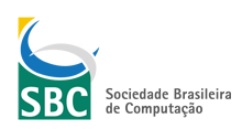Use of High Performance Computing in Agent-Based Social Simulation: A Case Study on Trust-Based Coalition Formation
Resumo
Computer models based on agents have shown to be very useful in the field of social simulation, especially for its versatility and ease to model complex systems. In the context of agent simulations, Nardin and Sichman developed a model for the study of coalition formation among agents, based on trust. Later, the need of more efficient ways for simulating the model was acknowledged in order to explore large-scale scenarios. The solution found was the adoption of a high performance agentbased computing platform. This article intends to explore the use of such platform on the Nardin and Sichman’s model by migrating its code to the Repast HPC tool, which is executed on the Blue Gene/P supercomputer.Referências
R. Axelrod, “Advancing the art of simulation in the social sciences,” Complexity, vol. 3, no. 2, pp. 16–22, 1997.
J. Banks, Ed., Handbook of Simulation : Principles, Methodology, Advances, Applications, and Practice. New York: John Wiley & Sons, 1998.
J. Ferber, Les Syst`emes Multi-Agents: Vers une Intelligence Collective, ser. Informatique, Intelligence Artificielle. Paris: InterEditions, 1995.
P. Davidsson, “Agent based social simulation: A computer science view,” Journal of Artificial Societies & Social Simulation, vol. 5, no. 1, p. 7, 2002. [Online]. Available: [link]
L. G. Nardin and J. S. Sichman, “Simulating the impact of trust in coalition formation: A preliminary analysis,” Advances in Social Simulation, Post-Proceedings of the Brazilian Workshop on Social Simulation, pp. 33–40, 2011.
U. Wilensky, NetLogo, Center for Connected Learning and Computer-Based Modeling, Northwestern University, Evanston, 1999. [Online]. Available: [link]
L. G. Nardin and J. S. Sichman, “Trust-based coalition formation: A multiagent-based simulation,” in Proceedings of the 4th World Congress on Social Simulation, Taipei, TW, 2012.
J. T. Murphy, “Computational social science and high performance computing: A case study of a simple model at large scales,” in Proceedings of the 2011 Computational Social Science Society of America Annual Conference, Santa Fe, 2011. [Online]. Available: [link]
N. Collier and M. North, “Parallel agent-based simulation with repast for high performance computing,” SIMULATION:Transactions of the Society for Modeling and Simulation International, pp. 1–21, 2012.
R. M. Fujimoto, Parallel and Distributed Simulation Systems, 1st ed., ser. Wiley series on parallel and distributed computing. New York: John Wiley & Sons, 2000.
M. Scheutz, P. Schermerhorn, R. Connaughaton, and A. Dingler, “SWAGES: an extendable distributed experimentation system for largescale agent-based ALife simulations,” in Proceedings of the 10th International Conference on the Simulation and Synthesis of Living Systems, 2006.
S. Coakley, M. Gheorghe, M. Holcombe, S. Chin, D. Worth, and C. Greenough, “Exploitation of high performance computing in the FLAME agent-based simulation framework,” in High Performance Computing and Communication 2012 IEEE 9th International Conference on Embedded Software and Systems (HPCC-ICESS), 2012 IEEE 14th International Conference on, 2012, pp. 538–545.
J. Banks, Ed., Handbook of Simulation : Principles, Methodology, Advances, Applications, and Practice. New York: John Wiley & Sons, 1998.
J. Ferber, Les Syst`emes Multi-Agents: Vers une Intelligence Collective, ser. Informatique, Intelligence Artificielle. Paris: InterEditions, 1995.
P. Davidsson, “Agent based social simulation: A computer science view,” Journal of Artificial Societies & Social Simulation, vol. 5, no. 1, p. 7, 2002. [Online]. Available: [link]
L. G. Nardin and J. S. Sichman, “Simulating the impact of trust in coalition formation: A preliminary analysis,” Advances in Social Simulation, Post-Proceedings of the Brazilian Workshop on Social Simulation, pp. 33–40, 2011.
U. Wilensky, NetLogo, Center for Connected Learning and Computer-Based Modeling, Northwestern University, Evanston, 1999. [Online]. Available: [link]
L. G. Nardin and J. S. Sichman, “Trust-based coalition formation: A multiagent-based simulation,” in Proceedings of the 4th World Congress on Social Simulation, Taipei, TW, 2012.
J. T. Murphy, “Computational social science and high performance computing: A case study of a simple model at large scales,” in Proceedings of the 2011 Computational Social Science Society of America Annual Conference, Santa Fe, 2011. [Online]. Available: [link]
N. Collier and M. North, “Parallel agent-based simulation with repast for high performance computing,” SIMULATION:Transactions of the Society for Modeling and Simulation International, pp. 1–21, 2012.
R. M. Fujimoto, Parallel and Distributed Simulation Systems, 1st ed., ser. Wiley series on parallel and distributed computing. New York: John Wiley & Sons, 2000.
M. Scheutz, P. Schermerhorn, R. Connaughaton, and A. Dingler, “SWAGES: an extendable distributed experimentation system for largescale agent-based ALife simulations,” in Proceedings of the 10th International Conference on the Simulation and Synthesis of Living Systems, 2006.
S. Coakley, M. Gheorghe, M. Holcombe, S. Chin, D. Worth, and C. Greenough, “Exploitation of high performance computing in the FLAME agent-based simulation framework,” in High Performance Computing and Communication 2012 IEEE 9th International Conference on Embedded Software and Systems (HPCC-ICESS), 2012 IEEE 14th International Conference on, 2012, pp. 538–545.
Publicado
26/05/2013
Como Citar
ROSSET, Luciano M.; NARDIN, Luis G.; SICHMAN, Jaime S..
Use of High Performance Computing in Agent-Based Social Simulation: A Case Study on Trust-Based Coalition Formation. In: WORKSHOP-ESCOLA DE SISTEMAS DE AGENTES, SEUS AMBIENTES E APLICAÇÕES (WESAAC), 7. , 2013, São Paulo/SP.
Anais [...].
Porto Alegre: Sociedade Brasileira de Computação,
2013
.
p. 161-163.
ISSN 2326-5434.
DOI: https://doi.org/10.5753/wesaac.2013.33191.



